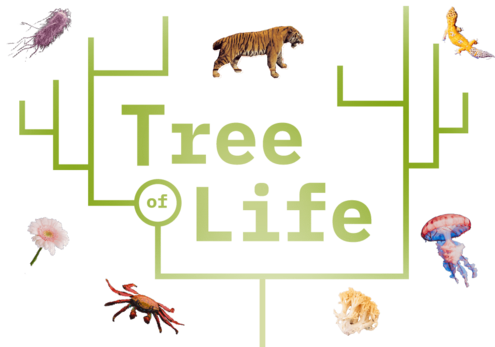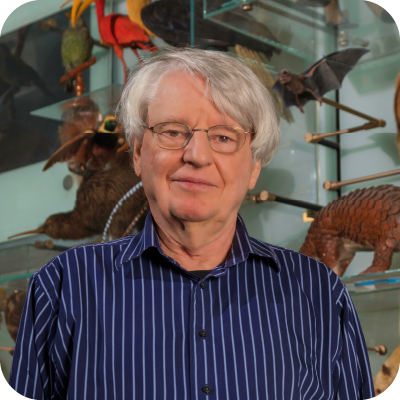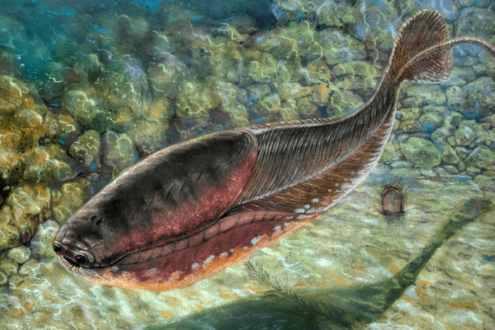



I'm Joel Cracraft, and I study birds at the American Museum of Natural History.
From blue-green algae to the Bald Eagle, there are over a million known species on our planet, Earth. This amazing array of life, or biodiversity, is everywhere you look—it’s even in places you can’t see, like deep underground.

Wherever they’re found, all living things are related because they all share a common ancestor. To show how species are related, scientists create diagrams called cladograms. Like a family tree, a cladogram shows close and distant relatives. Scientists call the family tree for all species on Earth the "Tree of Life."

Tree of Life
Cladogram
This cladogram shows a few important groups of species in the Tree of Life. There are many more known groups—and possibly millions more species yet to be discovered.


Life
All living things have cells that can make copies of their own DNA. DNA is a chemical that cells need to work and reproduce.

Eukaryotes
All eukaryotes have cells with a nucleus that contains most of the cell’s DNA.

Animals
All animals have a specific mix of proteins in the area between their cells. The mix includes the tough protein collagen.

Bilaterians
All bilaterians have mirror symmetry. That means if you draw a line along the length of their body, the right half is a mirror image of the left half.

Vertebrates
All vertebrates have backbones, which give their bodies rigid support.

Tetrapods
All tetrapods have four limbs with moveable joints surrounded by muscles. Even though some tetrapods—such as snakes—don’t have legs, their ancestors had them. You can see evidence of this in their skeletons.

Sauropsids
All sauropsids have two side-by-side openings in the roofs of their mouths called palatal openings. Blood vessels and nerves pass through these openings.

Diapsids
All diapsids have two openings on each side of their skulls behind their eyes. These openings are called temporal fossae.
Click on a node

to discover what these groups have in common.
Click on the
group names
to see what these living things look like.
Slices of Life
This chart shows the percentage of known species for different groups of organisms.

Arthropods: 48.20%
Echinoderms: 0.49%
Amphibians: 0.36%
Ray-Finned Fishes: 1.44%
True Bacteria: 0.98%
Protists: 20.99%
Lizards and Snakes: 0.48%
Green Plants: 16.05%
Mammals: 0.28%
Crocrodilians and Birds: 0.46%
Fungi: 6.20%
Cnidarians: 0.64%
Mollusks: 3.42%
Turtles and Tortoises: 0.02%
Click a name to see info about that group.
Image Credits:
Homepage: bilaterians, © Vlad Proklov/CC BY-NC 2.0; blood star, Gerald and Buff Corsi/© California Academy of Sciences; coral, © Birmingham Museums Trust/Unsplash; Corynebacterium diphtheriae, © CDC/Unsplash; crab, © Amy Perez/Unsplash; daisy, © AARN GIRI/Unsplash; diapsids, sauropsids, tetrapods, vertebrates, M. Shanley/© AMNH; DNA, © Biophoto Associates/Science Source; Escherichia coli, © CDC/Unsplash; eukaryotes, Cells with organelles courtesy University of Edinburgh; fungus, © Irina Iacob/Unsplash; jellyfish, © Marcos Paulo Prado/Unsplash; Joel Cracraft, D. Finnin/© AMNH; koi, © Mihai Avram/Unsplash; leopard gecko, © おにぎり/Unsplash; nudibranch, © Joan Li/Unsplash; sea sponge, © Adam Mastrfshrmn/CC BY 2.0; sea turtle, © David Troeger/Unsplash; tiger, D. Finnin/© AMNH; tree frog, © Darko Pribeg/Unsplash.
How to Read a Simple Cladogram: lemon, © Thitiphum Koonjantuek/Unsplash; orange, © Xiaolong Wong/Unsplash; peach, © Kelsey Curtis/Unsplash; plum, © Vladimir Gladkov/Unsplash; tomato, © Olga Finn/Unsplash; walnut, © Mockup Graphics/Unsplash; watermelon, © Olga Finn/Unsplash.
True Bacteria: Escherichia coli, NIAID; Nodularia sp, © rmatth/CC BY-NC-SA; Salmonella enterica, Medical Illustrator: James Archer/CDC; Staphylococcus sp, Courtesy of Louis de Vos, BIODIC.
Protists: Acetabularia sp, © alderash/CC BY-NC; Amoeba proteus, Navicula sp, Paramecium sp, Courtesy of Louis de Vos, BIODIC; Macrocystis pyrifera, Courtesy of Gary McCarthy; Tetrahymena pyriformis, © Picturepest/CC BY 2.0; Peridinium gatunense, © susan22carty/CC BY-NC.
Green Plants: American rockbrake, © Henrik Kibak/CC BY-4.0; Boojum tree, © Wendy Cutler/CC BY-SA 2.0; cassava plant, Courtesy of Roger Harris, Jungle Photos; Jeffrey pine, Robert Potts/© California Academy of Sciences; rosy periwinkle, Courtesy of James A. Manhart; yellow starthistle, Courtesy of Peggy Greb, Agricultural Research Service.
Fungi: giant puffball, hygroscopic earthstar, the sickener, turkey tails, woolly chanterelle, Br. Alfred Brousseau, Saint Mary's College/© California Academy of Sciences; jelly bellies, © Holger Krisp/CC BY-3.0; Penicillium chrysogenum, © Mary Gillham Archive Project; witch's butter, © Jean-Pol Grandmont/CC BY-3.0.
Cnidarians: California tube coral, Gerald and Buff Corsi/© California Academy of Sciences; eggyolk jellyfish, © Tom Thai/CC BY-2.0; gorgonian coral, © Fernando Herranz Martín/GPL; Portuguese man-of-war, Courtesy of Dr. Thomas M. Scott, Florida Geological Survey; smooth flower coral, © Cristian M. Galván Villa/CC BY-NC; swimming anemone, © Sara Thiebaud/CC BY-NC; symmetrical brain coral, © Ali and Brice/CC BY-NC; tube anemone, © Kathleen R./CC BY-NC.
Mollusks: chambered nautilus, © Orlando Bonney/CC BY-NC; cuttlefish, © Dr. Benjamin Titus/CC BY-NC; greater blue-ringed octopus, Courtesy of Roy Caldwell; opalescent inshore squid, purple-ringed top snail, Spanish shawl nudibranch, Courtesy of Gary McCarthy; robust lancetooth, © kholly/CC BY-NC; tidewater mucket, © Mike Jones/CC BY-NC.
Arthropods: Asian multicolored ladybird beetle, Formosan subterranean termite, Mediterranean fruit fly, mustached mud bee, Varroa mite, Courtesy of Scott Bauer, Agricultural Research Service; leafcutter ant, © Pjt56/CC BY 4.0; Mexican redknee tarantula, Sally lightfoot crab, ten-spot skimmer dragonfly, Gerald and Buff Corsi/© California Academy of Sciences; owl butterfly, © AMNH; pseudoscorpion, Courtesy of Carol Tingley, NC State Parks; yellow fever mosquito, Courtesy of Agricultural Research Service; white-tailed spider, © Steve Kerr/CC BY 4.0.
Echinoderms: bat star, blood star, sand dollar, Gerald and Buff Corsi/© California Academy of Sciences; chocolate chip sea cucumber, © Hans Hillewaert/CC BY-SA 4.0; slate pencil urchin, Eugene Weber/ © California Academy of Sciences; sunflower seastar, Sherry Ballard/ © California Academy of Sciences.
Ray-Finned Fishes: electric eel, © Brian Gratwicke/CC BY-NC 2.0; French angelfish, G. P. Schmahl, NOAA; honeycomb cowfish, © Kevin Bryant/CC BY-NC-SA 2.0; North Atlantic swordfish, M. Shanley/© AMNH; Pacific seahorse, © Trisha Fawver/CC BY-ND 2.0; pacu, © Ariel Rotondo/CC BY-NC; red lionfish, © Jens Petersen/CC BY 2.5.
Amphibians: American toad, blue poison frog, long-tailed salamander, red spotted newt, White's treefrog, John White/© California Academy of Sciences; Goliath frog, M. Shanley/© AMNH; hellbender, © Drew Kanes/CC BY-NC.
Mammals: aye-aye, M. Shanley/© AMNH; caracal, © Derek Keats/CC BY 2.0; dog, © Karen Taber; green acouchi, giant panda, reticulated giraffe, warthog, John White/© California Academy of Sciences; human, © Shutterstock; orca, © Sabine Templeton/CC BY-NC.
Turtles and Tortoises: Aldabra tortoise, map turtle, John White/© California Academy of Sciences; diamondback terrapin, © Todd Pierson/CC BY-NC; leatherback sea turtle, Courtesy Claudia Lombard, USFWS; radiated tortoise, © Charles J. Sharp/CC BY-SA 4.0.
Lizards and Snakes: corn snake, crocodile skink, eastern worm snake, northern redbelly snake, John White/© California Academy of Sciences; tusked chameleon, © California Academy of Sciences; Egyptian spiny-tailed lizard, © AMNH; king cobra, © Dr. Anand Titus and Geeta N. Pereira/CC BY-SA 2.0; King's alligator lizard, © AMNH; Komodo dragon, Gerald and Buff Corsi/© California Academy of Sciences.
Crocodilians and Birds: American crocodile, Gerald and Buff Corsi/© California Academy of Sciences; American Robin, Tom Koerner, USFWS; California Condor, Snowmanradio, USFWS; Emu, Larry Rana, USDA; Greater Bird of Paradise, © AMNH; Morelet's crocodile, Schneider's dwarf caiman, John White/© California Academy of Sciences; Snowy Owl, © NaturesPhotoAdventures/CC BY-SA 3.0; Whooping Crane, © Gary Leavens/CC BY-SA 2.0.




 Biodiversity
Biodiversity
 Brain
Brain
 Genetics
Genetics
 Marine BiOLogy
Marine BiOLogy
 MicrobiOLogy
MicrobiOLogy
 PaleontOLogy
PaleontOLogy
 ZoOLogy
ZoOLogy
 AnthropOLogy
AnthropOLogy
 ArchaeOLogy
ArchaeOLogy
 Astronomy
Astronomy
 Climate Change
Climate Change
 Earth
Earth
 Physics
Physics
 Water
Water








